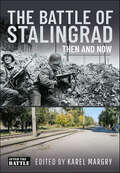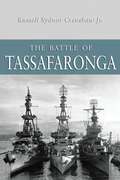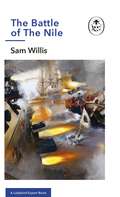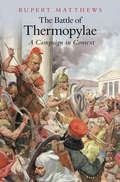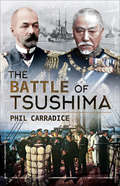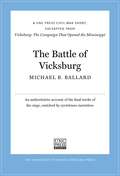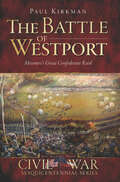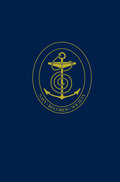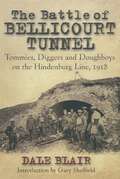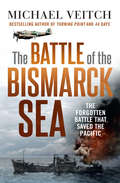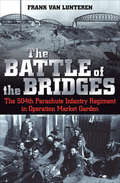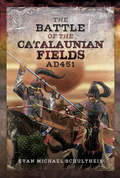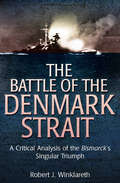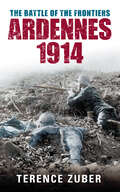- Table View
- List View
The Battle of St. Vith, Defense and Withdrawal by Encircled Forces: German 5th & 6th Panzer Armies Versus U.S. 7th Armored Division and Attachments, 17-23 December 1944
by Major Paul J. St. LaurentWhen the German Ardennes Offensive of December 1944 ruptured the front of the U.S. First Army, Major General Troy Middleton committed his VIII Corps to the defense of selected transportation bottlenecks in the path of the German advance. St. Vith, located in the central sector of the Ardennes battleground, was one of these. Although by passed by German spearheads bound for the Meuse River, the 7th Armored Division (plus major elements of three other divisions) held the position against major elements of two German Panzer armies. After six days of tenacious defense while practically encircled, the St. Vith force was ordered to withdraw. The defenders of St. Vith prevented the Germans from effectively supplying their armored spearheads, drew off their follow-on forces, and bought time for the U.S. First Army to consolidate its position on the north flank of the German penetration.
The Battle of Stalingrad: Then and Now
by Karel Margry"The combination of past and contemporary pictures regarding battle locations is of a great service for those of us with a passion for history." — Globe at War Stalingrad was not only the most-crucial battle on the Eastern Front, it was the main turning point of the whole Second World War in Europe. The Third Reich had suffered setbacks earlier, notably at El Alamein in North Africa in October 1942, but the scale of the fighting on the Eastern Front was incomparably larger than any of the other war fronts and it was the fate of the armies there that decided the outcome of the global conflict. After the demise of the German 6. Armee at Stalingrad in February 1943 it was clear that Nazi Germany would lose the war. This book brings together three After the Battle stories devoted to that historic struggle. It opens with a detailed account of the fight for the city of Voronezh. Lying on the great Don river, it was a prime initial objective of the German summer offensive towards the Caucasus launched on June 28, 1942. Possession of Voronezh would secure an eastern anchor point for a northern defensive line needed for the southward advance to Stalingrad. The city was taken with relative ease in early July but, when the Soviets launched a counter-offensive, the Heeresgruppe Süd commander, Generalfeldmarschall Fedor von Bock, allowed his panzer and motorised divisions to be drawn into the protracted fight. This week-long delay – which infuriated Hitler – severely disrupted the timetable for the main offensive, and fatally contributed to the failure to seize Stalingrad in a surprise raid. The main part of the book is taken up by a comprehensive description of the gargantuan seven-month battle for Stalingrad itself. All stages are described in detail: the advance of the German armies to the city in August, the stubborn and heroic defense of the besieged Soviet 62nd Army against overwhelming German superiority in September-November; and the subsequent encirclement and annihilation of the doomed 6. Armee in the winter, ending in total capitulation on February 2, 1943. Due to the wholesale destruction of the embattled city, it was long thought impossible to apply After the Battle’s ‘then and now’ format to Stalingrad but with the help of a local expert and acknowledged student of the battle, Alexander Trofimov, we managed to match up numerous combat photos taken all over the city, giving full treatment to the months-long struggle for the city on the Volga. The same goes for Voronezh where we found another local expert, Sergey Popov, who achieved equally astounding comparisons. Without them, this book could not have been made. The German catastrophe at Stalingrad, with around 150,000 men killed or succumbing to the winter cold and around 100,000 taken prisoner (of whom only some 5,000 survived captivity), remained a national trauma in Germany. Coming to terms with the event proved difficult, the sorrow over the loss of so many German lives being surmounted by guilt over the fact that Germany had been the aggressor. In many ways, Stalingrad became a taboo, remembered in silence but avoided in public discussion. Illustrative of this is the fact that it took a full 50 years before a major feature film on Stalingrad could be produced in Germany. It was only in 1992 that the German film industry felt the time was ripe and produced and released Stalingrad, the first full-fledged war movie on the battle. We include the story of the making of this film as an epilogue to the main story.
The Battle of Tassafaronga
by Russell Crenshaw Jr.The Battle of Tassafaronga, November 30, 1942, was the fifth and last major night surface action fought off Savo Island during World War II s Guadalcanal campaign. It ended a string of Japanese victories, but it was also a horrible embarrassment to the U.S. Navy, which had three heavy cruisers damaged and one sunk to enemy torpedoes. After the battle, American commanders erroneously reported that multiple enemy ships had been sunk or seriously damaged, leading Admiral Nimitz to focus on training as the missing ingredient. Not until more than half a century later did Captain Russell S. Crenshaw, Jr., the destroyer Maury s gunnery officer during the battle, discover that the outcome hinged instead on critical shortcomings that had been built into the U.S. Navy before the war defective torpedoes, poor intelligence, blinding gunfire, over-confidence, and a tendency to equate volume of fire with effectiveness of fire factors that turned the battle into a crucible in which the very nature of the U.S. Navy and its weapons was tested [and] a miniature of what might have been, under other circumstances, a truly devastating defeat.
The Battle of The Nile: A Ladybird Expert Book (The Ladybird Expert Series #35)
by Sam WillisPart of the ALL-NEW LADYBIRD EXPERT SERIES- Why was the Battle of the Nile so decisive in the French Revolutionary Wars?- Why did the French believe they were unassailable?- And why did Nelson and the British win?TRACK the revolutionary roots and dramatic turning points of the British Royal Navy's glorious victory over the French naval expedition to Egypt. From Napoleon's rise to prominence to Nelson's celebrated tactical leadership, discover how this significant battle changed the face of the French Revolutionary Wars.THE BATTLE THAT CHANGED THE BALANCE OF POWER IN EUROPEWritten by historian, archaeologist, and broadcaster Sam Willis, Nelson: Battle of the Nile is a thrilling and accessible account of the naval battle that established Nelson's fame.
The Battle of Thermopylae: A Campaign in Context
by Rupert Matthews‘Tell the Spartans, stranger passing by, that here obedient to their laws we lie.’ One of the most remarkable actions in ancient or modern military history took place at Thermopylae in 480BC. Rupert Matthews has personally examined the battlefield in order to try to explain how 300 Spartans could hold at bay the hordes of the Persian Emperor Xerxes. This was no vain sacrifice; the delay gave breathing space for the Greek states to organise their defence, and ultimately defend successfully their homelands. Among other intriguing revelations the author explains the importance of the half-ruined wall that sheltered the Spartans against the onslaught. With concise diagrams and maps of the entire campaign, the reader can begin to understand the extraordinary, apparently impossible outcome of the war.
The Battle of Tsushima
by Phil CarradiceThe author of The First World War in the Air details the gripping 1905 naval battle during the Russo-Japanese War.In 1905 Japan and Russia were at war. With the Russian Far East Fleet destroyed, the Czar sent his Baltic Fleet halfway around the world to exact revenge. This mammoth journey took many months and was an amazing feat of seamanship. But, at the end of this adventure, the Russians were totally overwhelmed, and the majority of the fleet was underwater. There was no alternative for the Czar but to sue for an ignominious peace.The story of the journey and the final battle remain fascinating, the people involved behaving like characters from a novel. Russian Admiral Rozhestvensky was a gunnery expert but had never held active command in a major sea battle. Japanese Admiral Togo had trained in Britain, enlisting as a cadet on the Training Ship Worcester, even though he was far too old and was forced to lie about his age. Inept generalship on the part of the Russians, combined with brilliant seamanship from Togo, saw the complete destruction of the Russian fleet.The naval battle of Tsushima is one of the forgotten actions of the twentieth century, but it has a significance that is immense in world history.“An utterly compelling story, well told by Carradice. We really sympathize with the Russian sailors, trapped on their ironclad warships for months as they battled against the elements, a largely hostile world, and even each other. The result is an excellent book that reminds us of the human cost of these massive naval battles.” —History of War
The Battle of Verdun
by Alan AxelrodThe Great War ate men, machines, and money without mercy or remission. At the end of 1915, the German army chief of staff, Erich von Falkenhayn, believed he knew how to finally kill the beast and win the war. On Christmas day, 1915, Falkenhayn sent a letter to Kaiser Wilhelm II proposing a campaign to demoralize Britain, whose industrial might and maritime power were the foundation of the alliance against Germany, while also knocking France out of the war. He wrote that the &“strain on France has reached breaking point …. If we succeed in opening the eyes of her people to the fact that in a military sense they have nothing more to hope for, that breaking point would be reached and England&’s best sword knocked out of her hand.&” His plan was to attack a single point the French perceived as so vital that they would be compelled &“to throw in every man they have.&” Falkenhayn concluded: &“If they do so, the forces of France will bleed to death&” or, as he put it later, the &“French army would be bled white.&” Falkenhayn&’s target of choice was Verdun, a place that, throughout virtually all of the history of Europe, had been a fortress. Located within a loop of the Meuse River, it occupied a strategic blocking position in the Meuse River valley. As recently as the Franco-Prussian War of 1871, Verdun had been the last of the French fortified cities to hold out against the German onslaught. After that war, it had been vastly augmented, so that it was now a circle of detached forts surrounding a central citadel. The town of Verdun itself, also fortified, was likewise encircled by forts distributed in a five-mile radius. The combined massive complex guarded not only passage through the river valley region, but also dominated a key railroad junction leading to points south, southwest, west, and north in France. Along with the related, but separate, Battle of the Somme, Verdun was among the most deadly battles in history. To understand this struggle is to understand all of World War I, including the principal stated motive of Woodrow Wilson for bringing the United States into the &“European War&” in April 1917. For him, Verdun proved both France&’s determination to win at all costs and the likelihood that, without help, it would be defeated nevertheless. The unparalleled barbarity of Verdun, a product of the Old World, convinced the American president that only the principal nation of the New World could finally alter the grim course of human destiny. While many, both in 1916 and in the decades that followed, saw Verdun as a bloody monument to the inescapable futility of war, Wilson saw in it a hope for fighting what he would call a &“war to end all wars.&”
The Battle of Verneuil 1424: A Second Agincourt
by Richard WadgeIn August 1424 the armies of England, Scotland and France met in the open fields outside the walls of Verneuil in a battle that would decide the future of the English conquests in France. The hero king, Henry V, had been dead for two years and the French felt that this was their chance to avenge their startling defeat at Agincourt, and recover the lands that Henry had won for England. Despite its importance, the battle is largely overlooked in accounts of the Hundred Years War. The Battle of Verneuil 1424 is the first proper account of the battle, and is also one of the first books to outline the important part the Scots played in the wars in France in the years between the two great battles of Agincourt and Verneuil.
The Battle of Vicksburg
by Michael B. BallardThe Vicksburg campaign was among the longest of the Civil War, lasting from 26 May 1862 to 4 July 1863. This Civil War Short provides a compelling narrative of the final six weeks of the campaign, excerpted from Michael Ballard's Vicksburg: The Campaign That Opened the Mississippi, which blends strategy and tactics with the human element, reminding us that while Gettysburg has become the focal point of the history and memory of the Civil War, the outcome at Vicksburg was met with as much celebration and relief in the North as the Gettysburg victory, and it should be viewed as equally important today.UNC Press Civil War Shorts excerpt rousing narratives from distinguished books published by the University of North Carolina Press on the military, political, social, and cultural history of the Civil War era. Produced exclusively in ebook format, they focus on pivotal moments and figures and are intended to provide a concise introduction, stir the imagination, and encourage further exploration of the topic. For in-depth analysis, contextualization, and perspective, we invite readers to consider the original publications from which these works are drawn.
The Battle of Waterloo
by Jeremy BlackThe name Waterloo has become synonymous with final, crushing defeat. Now thislegendary battle is re-created in a groundbreaking book by an eminent Britishmilitary historian making his major American debut.
The Battle of Westport: Missouri's Great Confederate Raid (Civil War Sesquicentennial Series)
by Paul KirkamnThe story of the largest Civil War battle west of the Mississippi, in what would one day become Kansas City, and the role it played in American history. The Battle of Westport, Missouri—today part of Kansas City—was fought by troops from as far away as New Jersey and Pennsylvania, as well as Texas, Arkansas, Colorado and Iowa. It was the climax of a desperate Confederate raid led by General Sterling Price proceeding from Arkansas across the State of Missouri to the Kansas border. The Union victory at Westport marked the end of major military operations in Missouri and secured Kansas and the trails, rails, and communication lines to the western states. Participants included future governors of both Kansas and Missouri, notorious postwar outlaws, and many notable characters who would shape the growth and image of the western states. This book tells the story of the place, the engagement, the people, and the importance of the Missouri/Kansas border war&’s greatest battle. In addition, the aftermath and legacy of the Battle of Westport is presented in the broader context of westward expansion, giving readers a greater appreciation of how far-reaching the effects were of those few days in October, 1864.
The Battle of Wisconsin Heights, 1832: Thunder on the Wisconsin (War Era And Military Ser.)
by Patrick J JungThe story of a devastating episode of the brief, bloody Black Hawk War—includes illustrations. The brief war that Black Hawk waged against the United States in 1832 saw half of the people under his leadership killed in savage massacres and the entire Sauk tribe removed to Iowa. Yet this dismal outcome cannot obscure the superb military leadership that Black Hawk demonstrated during many phases of the war. His crowning glory occurred at a place called Wisconsin Heights, where his force of about 120 warriors held off an estimated 700 American militia volunteers while the women, children and elderly under his protection escaped across the Wisconsin River. This book tells the dramatic story and includes maps and illustrations.
The Battle of Znaim: Napoleon, the Habsburgs and the end of the War of 1809
by John H. GillThe acclaimed Napoleonic historian sheds new light on a fascinating yet little-known battle in the Franco-Austrian War.Occurring in July of 1809, the Battle of Znaim was the last to be fought on the main front of the Franco-Austrian War. Cut short to make way for an armistice it effectively ended hostilities between France and Austria and is now considered a unique episode of simultaneous conflict and diplomacy.The battle began as a result of the Austrian decision to stage a rearguard action near Znaim, prompting the Bavarians to unsuccessfully storm a nearby town. As the battle progressed over the course of the two days, the village changed hands a number of times.Historian John H. Gill delves into the tactics of both sides as the two armies continually changed positions and strategies. His account dissects and investigates the dual aspects of the Battle of Znaim and explains the diplomatic decisions that resulted in the peace treaty which was signed at Schonbrunn Palace on October 14th, 1809.
The Battle of the Atlantic and Signals Intelligence: U–Boat Situations and Trends, 1941–1945
by David SyrettThis title was first published in 2002. This book contains the U-boats situations and trends written by the staff of the Admiralty’s Operational Intelligence Centre during the Second World War. Based largely on communications intelligence, the U-boat situations and trends were designed to inform a small number of senior officers and high officials of the latest events and developments in the Allied war against the U-boats. The Battle of the Atlantic and the war against the U-boats was the longest and the most complex naval battle in history. In this huge conflict which sprawled across the oceans of the world the U-boats sank 2,828 Allied merchant ships while the Allies destroyed more than 780 German U-boats. These documents relate on a weekly, and in some cases a daily, basis exactly what the Allies knew concerning the activities of the U-boats during the Battle of the Atlantic.
The Battle of the Atlantic: Fighting The U-boats In The Battle Of The Atlantic (Sven Hassel War Classics)
by Donald MacintyreAn eyewitness account of the fight for supremacy at sea during World War II, as told by a man who was in the thick of combat against Nazi Germany. The Battle of the Atlantic was an unremitting assault by enemy boats and aircraft against Allied merchant ships that were the lifeline of Great Britain—and the vigilant defense against them made by the Royal Navy and other allied forces. Captain Donald Macintyre—a winner of the Distinguished Service Cross who participated in the fighting, escorting over 1,100 ships and losing only two—tells the story with immediacy and clarity. He describes the measures employed to defeat the amazingly successful ‘wolf-pack’ tactics of the U-boats, the convoy system and individual convoys, never shirking from how desperately close to defeat the Allies were at times. Not only does he analyze the strategic issues of the day, he also describes the battle from the viewpoint of the participants themselves. The long, drawn-out duels between escort and U-boat are made vivid by quotations from the log-books of some of the ablest escort-commanders as well as combat reports of the German U-boat captains. Featuring dozens of rare wartime photographs drawn from both German and British sources, this account of the sacrifice and savagery of war makes the courage and endurance of those who fought in the Atlantic all the more palpable.
The Battle of the Bellicourt Tunnel: Tommies, Diggers and Doughboys on the Hindenburg Line, 1918
by Dale BlairIn the summer and autumn of 1918, the British Expeditionary Force, under Field Marshal Haig, fought a series of victorious battles on the Western Front that contributed mightily to the German Army’s final defeat. They did so as part of an Allied coalition, one in which the role of Australian diggers and US doughboys is often forgotten. The Bellicourt Tunnel attack in September 1918, fought in the fading autumn light, was very much an inter-Allied affair and marked a unique moment in the Allied armies’ endeavors. It was the first time that such a large cohort of Americans had fought in a British formation. Additionally, untried American II Corps and experienced Australian Corps were to spearhead the attack under the command of Lieutenant General Sir John Monash, with British divisions adopting supporting roles on the flanks. Blair forensically details the fighting and the largely forgotten desperate German defenxe. Although celebrated as a marvelous feat of breaking the Hindenburg Line, the American attack generally failed to achieve its set objectives and it took the Australians three days of bitter fighting to reach theirs. Blair rejects the conventional explanation of the US mop up failure and points the finger of blame at Rawlinson, Haig and Monash for expecting too much of the raw US troops, singling out the Australian Corps commander for particular criticism. Overall, Blair judges the fighting a draw. At the end, like two boxers, the Australian-American force was gasping for breath and the Germans, badly battered, were backpedalling to remain on balance. That said, the day was calamitous for the German Army, even if the clean breakthrough that Haig had hoped for did not occur. Forced out of the Hindenburg Line, the prognosis for the German army on the Western Front and hence Imperial Germany itself was bleak indeed.
The Battle of the Berezina: Napoleon's Great Escape (Campaign Chronicles)
by Alexander MikaberidzeThe full story of Napoleon&’s legendary escape from Russia under seemingly impossible odds is recounted in this thrillingly vivid military history. In the winter of 1812, Napoleon's army retreated from Moscow under appalling conditions, hunted by three separate Russian armies. By late November, Napoleon had reached the banks of the River Berezina—the last natural obstacle between his army and the safety of the Polish frontier. But instead of finding the river frozen solid enough to march his men across, an unseasonable thaw had turned the Berezina into an icy torrent. Having already ordered the burning of his bridging equipment, Napoleon's predicament was serious enough: but with the army of Admiral Chichagov holding the opposite bank, and those of Kutusov and Wittgenstein closing fast, it was critical. In a gripping narrative that draws on contemporary sources—including letters, diaries and memoirs—Alexander Mikaberidze describes how Napoleon rose from the pit of despair to execute one of the greatest escapes in military history.
The Battle of the Berezina: Napoleon's Great Escape (Campaign Chronicles)
by Alexander MikaberidzeThe full story of Napoleon&’s legendary escape from Russia under seemingly impossible odds is recounted in this thrillingly vivid military history. In the winter of 1812, Napoleon's army retreated from Moscow under appalling conditions, hunted by three separate Russian armies. By late November, Napoleon had reached the banks of the River Berezina—the last natural obstacle between his army and the safety of the Polish frontier. But instead of finding the river frozen solid enough to march his men across, an unseasonable thaw had turned the Berezina into an icy torrent. Having already ordered the burning of his bridging equipment, Napoleon's predicament was serious enough: but with the army of Admiral Chichagov holding the opposite bank, and those of Kutusov and Wittgenstein closing fast, it was critical. In a gripping narrative that draws on contemporary sources—including letters, diaries and memoirs—Alexander Mikaberidze describes how Napoleon rose from the pit of despair to execute one of the greatest escapes in military history.
The Battle of the Bismarck Sea
by Michael VeitchIn the thick of World War II, during the first week of March 1943, Japan made a final, desperate lunge for control of the South West Pacific. In the ensuing Battle of the Bismarck Sea, a force of land-based Australian and American planes attacked a massive convoy of Japanese warships. The odds were against them. But a devastating victory was won and Japan's hopes of regaining the initiative in New Guinea destroyed. More importantly for Australians, the victory decisively removed any possibility that Australia might be invaded by Japanese forces. It was, for us, one of the most significant times in our history - a week when our future was profoundly in the balance. Bestselling author Michael Veitch tells the riveting story of this crucial moment in history - how the bravery of young men and experienced fighters, renegades and rule-followers, overcame some of the darkest days of World War II.
The Battle of the Bridges: The 504th Parachute Infantry Regiment in Operation Market Garden
by Frank van Lunteren&“On these pages, the human story comes to life, sometimes tragic, sometimes amusing, but always poignant and compelling&” (John C. McManus, author of Fire and Fortitude). Operation Market Garden has been recorded as a complete Allied failure in World War II, an overreach that resulted in an entire airborne division being destroyed at its apex. However, within that operation were episodes of heroism that still remain unsung. On September, 17, 1944, the 504th Parachute Infantry Regiment, 82nd Airborne Division, floated down across the Dutch countryside, in the midst of German forces, and proceeded to fight their way to vital bridges to enable the Allied offensive to go forward. The 101st Airborne was behind them; the British 1st Airborne was far advanced. In the 82nd&’s sector, the crucial conduits needed to be seized. The Germans were as aware of the importance of the bridge over the Waal River at Nijmegen as James Gavin and his 82nd troopers were. Thus began a desperate fight for the Americans to seize it, no matter what the cost. The Germans would not give up, however, and fought tenaciously in the town and fortified the bridge. On September 20, Gavin turned his paratroopers into sailors and conducted a deadly daylight amphibious assault in small plywood and canvas craft across the Waal River to secure the north end of the highway bridge in Nijmegen. German machine guns and mortars boiled the water on the crossing, but somehow, a number of paratroopers made it to the far bank. Their ferocity rolled up the German defenses, and by the end of the day, the bridge had fallen. This book by Dutch historian Frank van Lunteren draws on a plethora of previously unpublished sources to shed new light on the exploits of the &“Devils in Baggy Pants.&” A native of Arnhem—the site of the &“Bridge Too Far&”—the author draws on nearly 130 interviews he personally conducted with veterans of the 504th, plus Dutch civilians and British and German soldiers, who here tell their story for the first time.
The Battle of the Bulge: Hitler's Final Gamble
by Patrick DelaforceBy late 1944 the Allies were poised to smash the Siegfried Line and break into Germany. Supply lines were shorter thanks to the port of Antwerp. Arnhem aside, there had been a long run of victories and there was no intelligence even from ULTRA to suggest a German counter-offensive.So the major December attack through the mountainous Ardennes by massed Panzers and infantry took the Allies totally by surprise. Fog and low cloud negated the Allies' air supremacy, English-speaking German commandos in captured jeeps created panic and withdrawal of US forces became a near rout with morale all but broken.For ten days the situation worsened and Antwerp was seriously threatened and 21st Army Group in danger of being cut off.Clear skies for the Thunderbolts and coherent counter-attacks by rapidly deployed reinforcements turned the tide in the nick of time, so preventing a catastrophic defeat for the Allies.All this and more is graphically narrated in this fine study of a pivotal battle, that so nearly changed the course of war.
The Battle of the Bulge: Perspectives from Hitlers High Command
by Danny S. ParkerAs Allied armies swept towards the Reich in late 1944, the German high command embarked on an ambitious plan to wrest the initiative on the Western Front and deal a crippling blow to the Allied war effort. This superb book brings together a wealth of primary source material - including German documentation and debriefs of German generals - to tell the story of this famous campaign from the German point of view. Expertly edited by the acclaimed historian Danny S. Parker, this is an impressive volume which sheds fascinating light on one of the most crucial episodes of the Second World War.
The Battle of the Catalaunian Fields AD 451: Flavius Aetius, Attila the Hun and the Transformation of Gaul
by Evan Michael SchultheisA reassessment of the famous fifth-century clash between Hun and Roman forces: &“An excellent job of research with original documents.&” —The Past in Review This book reconsiders the evidence for Attila the Hun&’s most famous battle, the climax of his invasion of the Western Roman Empire that had reached as far as Orleans in France. Traditionally considered one of the pivotal battles in European history, saving the West from conquest by the Huns, the Catalaunian Fields is here revealed to be significant but less immediately decisive than claimed. This new study exposes oversimplified views of Attila&’s army, which was a sophisticated and complex all-arms force, drawn from the Huns and their many allies and subjects. The &‘Roman&’ forces, largely consisting of Visigoth and Alan allies, are also analyzed in detail. The author, a reenactor of the period, describes the motives and tactics of both sides. Drawing on the latest historiography and research of the primary sources, and utilizing Roman military manuals, Evan Schultheis offers a completely new tactical analysis of the battle and a drastic reconsideration of Hun warfare, the Roman use of federates, and the ethnography of the Germanic peoples who fought for either side. The result is a fresh and thorough case study of battle in the fifth century. Includes maps and illustrations
The Battle of the Denmark Strait: A Critical Analysis of the Bismarck's Singular Triumph
by Robert WinklarethThis detailed analysis of the WWII naval battle by the acclaimed historian and mechanical engineer reveals new insight into the Bismarck&’s victory. In the spring of 1942, Nazi Germany unleashed its behemoth battleship Bismarck against the British in the Battle of the Denmark Strait. Bismarck destroyed the pride of the Royal Navy, HMS Hood, and severely damaged its newest battleship, HMS Prince of Whales. The decisive victory resonated both in Whitehall and Berlin—and yet there continues to be controversy as to how the conflict was actually fought. The Battle of the Denmark Strait offers a detailed technical analysis of combat circumstances, while new discoveries, revealed for the first time in this book, shed light on the battle. With a close examination of naval gunnery, from the various gun systems to the flight time of shells to their target, historian and mechanical engineer Robert Winklareth has painstakingly reconstructed the battle. He also explores events leading up to the titanic clash, as well as its aftermath.
The Battle of the Frontiers: Ardennes 1914
by Terence ZuberLike the Battle of Verdun, the Battle of the Frontiers has often been ignored by military historians, who assumed that the French lost the first battles of the World War I because they launched suicidal bayonet charges against German machine guns. Therefore, for nearly a century, these battles have been considered uninteresting. In reality, these were some of the most important, hard-fought and instructive battles of the First World War.The Battle of the Frontiers is the first history of this battle in English and is based on ground-breaking research conducted in French and German army archives. It also makes use of neglected French and German books and articles, as well as German regimental histories, and includes personal accounts by participants such as Manfred von Richthofen (when he was still a cavalry lieutenant) and the young Erwin Rommel. Terence Zuber here presents a dramatic new perspective on combat in 1914.

